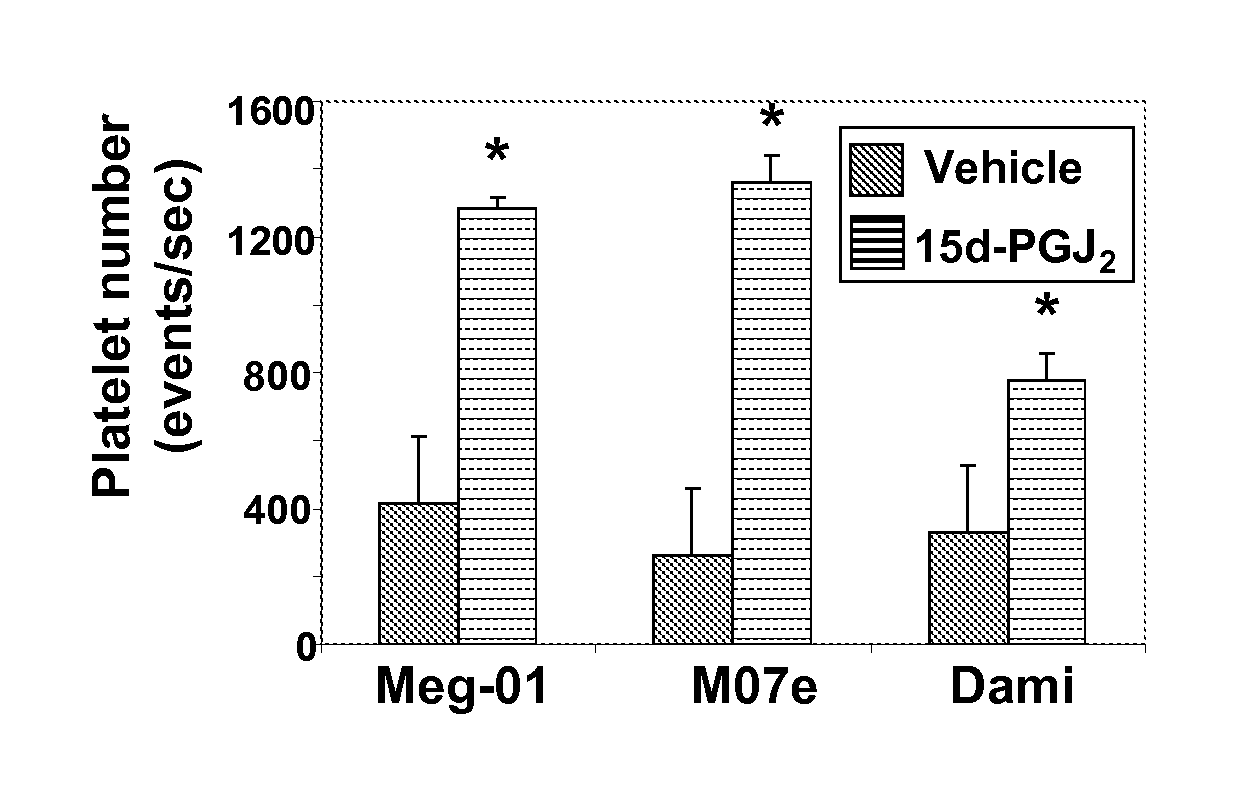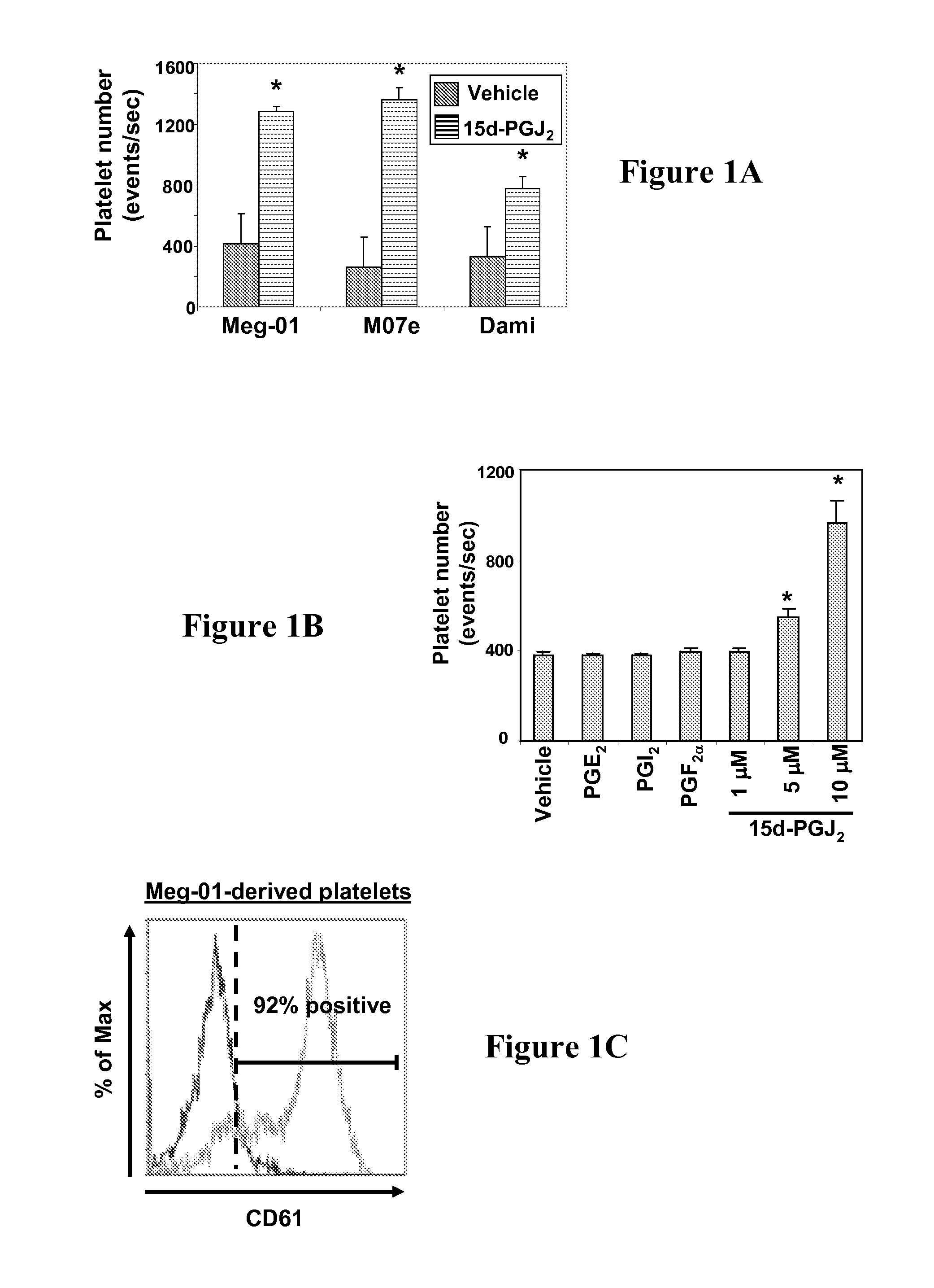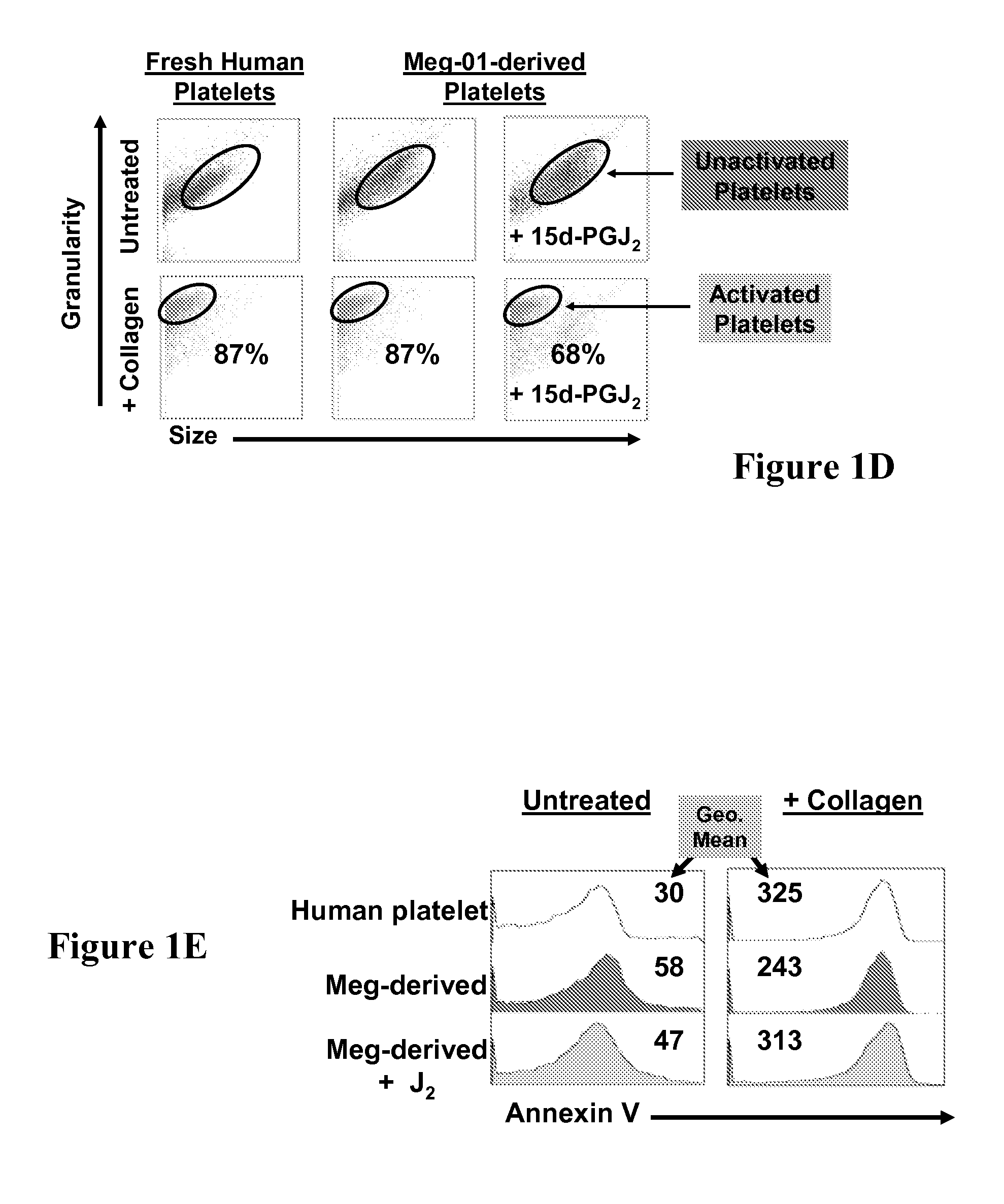Use of electrophilic compounds for inducing platelet production or maintaining platelet function
a technology of electrophilic compounds and platelets, which is applied in the direction of elcosanoid active ingredients, peptide/protein ingredients, extracellular fluid disorder, etc., can solve the problems of increasing the risk of inflammation and disease transmission, increasing the cost of platelet transfusion, and many victims without treatment, etc., to increase the maturation and platelet production, promote platelet formation, and enhance platelet production
- Summary
- Abstract
- Description
- Claims
- Application Information
AI Technical Summary
Benefits of technology
Problems solved by technology
Method used
Image
Examples
example 1
Small Electrophilic Molecules Induce Platelet Formation
[0078]Initial studies demonstrated that three well-described megakaryocytic cell lines (Meg-01, M07e, Dami) all increased platelet production after exposure for 24 h to 15d-PGJ2 (FIG. 1A). Further studies were completed on Meg-01 cells, as this cell produces platelets similar in structure and function to freshly isolated human platelets (Takeuchi et al., “Production of Platelet-like Particles by a Human Megakaryoblastic Leukemia Cell Line (MEG-01),”Exp Cell Res 193:223-226 (1991), which is hereby incorporated by reference in its entirety. Treatment of Meg-01 cells with increasing concentrations of 15d-PGJ2 caused a dose-dependent increase in platelet production (FIG. 1B). However, not every type of prostaglandin enhanced platelet production. For example, PGE2, PGI2 and PGF2α failed to enhance platelet production (FIG. 1B). Platelets derived from Meg-01 cells express the platelet marker CD61 (glycoprotein IIIa, FIG. 1C).
[0079]It ...
example 2
15d-PGJ2 Promotes Platelet Production from Cultured Mouse Megakaryocytes
[0081]To evaluate whether 15d-PGJ2 affects platelet production from normal mouse megakaryocytes, primary mouse bone marrow cells were cultured for 5 days with rhTPO to promote megakaryocyte enrichment and maturation. Following culture, bone marrow cells were treated with 15d-PGJ2 for 24 h. 15d-PGJ2 increased the percentage of CD61+ platelets in culture by ˜14% (FIG. 2A). These mouse bone marrow-derived platelets exhibited normal responses to collagen, as they changed shape (decrease in size and increase in granularity) and increased their surface expression of CD41 (GPIIb, FIGS. 2B-C). Geometric mean fluorescence intensity increased from 9 to 20 after collagen treatment. Mouse bone marrow culture-derived platelets show functionality, as they spread in response to fibrinogen (FIG. 2D). 15d-PGJ2 also induced the appearance of ruffled edges on the megakaryocytes, commonly observed during membrane blebbing of platel...
example 3
15d-PGJ2 Promotes Platelet Production from Cultured Human Megakaryocytes
[0082]Cord blood-derived CD34+ cells (99% pure) were cultured for 14 days with rhTPO, at which time more than 90% of the cells expressed CD61. The cultures consisted of a mixed population of both immature and mature megakaryocytes as determined by ploidy observed by Diff-Quik staining. These CD61+ cells were then treated with 15d-PGJ2 (10 μM) for 24 h and platelet production was assessed by flow cytometry. Treatment with 15d-PGJ2 doubled the number of platelets generated from these human megakaryocytes as determined by presence of the platelet marker CD61 and the absence of DNA (FIG. 3A). Flow cytometric data showed that human culture-derived platelets exhibited normal responses to collagen, as they changed shape (decrease in size and increase in granularity) and increased their surface expression of CD61 (FIGS. 3B-C). Geometric mean fluorescence intensity increased from 5 to 20 after collagen treatment. In addi...
PUM
| Property | Measurement | Unit |
|---|---|---|
| Electrical conductance | aaaaa | aaaaa |
| Electrical conductance | aaaaa | aaaaa |
| Time | aaaaa | aaaaa |
Abstract
Description
Claims
Application Information
 Login to View More
Login to View More - R&D
- Intellectual Property
- Life Sciences
- Materials
- Tech Scout
- Unparalleled Data Quality
- Higher Quality Content
- 60% Fewer Hallucinations
Browse by: Latest US Patents, China's latest patents, Technical Efficacy Thesaurus, Application Domain, Technology Topic, Popular Technical Reports.
© 2025 PatSnap. All rights reserved.Legal|Privacy policy|Modern Slavery Act Transparency Statement|Sitemap|About US| Contact US: help@patsnap.com



